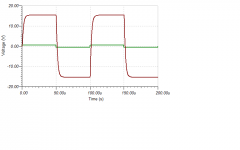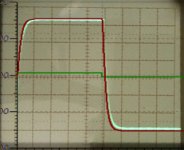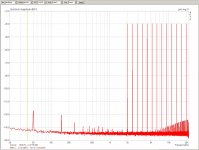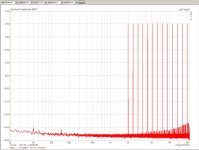Hi Dario,
i have an older MyREF with older BOM and noticed in newer BOM for C7 you recommend only wima FKP2.
What happened with ERo1834, you don't like it anymore ?
I still use Myref from time to time and discovered on my new 4ohm Dynaudio Focus 160 speakers bass is a bit shy, changed C9 from BlackGate PK (220uf/4v) to Nichicon Finegold 220uf/50v and bass response is a bit better (ordered also 220uf/50v Cerafines that you recommend).
Can you name some parts responsible with bass "adjustment" ?
Thanks,
Adrian
i have an older MyREF with older BOM and noticed in newer BOM for C7 you recommend only wima FKP2.
What happened with ERo1834, you don't like it anymore ?
I still use Myref from time to time and discovered on my new 4ohm Dynaudio Focus 160 speakers bass is a bit shy, changed C9 from BlackGate PK (220uf/4v) to Nichicon Finegold 220uf/50v and bass response is a bit better (ordered also 220uf/50v Cerafines that you recommend).
Can you name some parts responsible with bass "adjustment" ?
Thanks,
Adrian
Last edited:
Thanks Dario, I can't find the datasheet anywhere , but where are those capacitors suitable for?sorry for the off topic
Simply Google for "B41684" (read from your pic).
The first two results point to the datasheeet.
Hi Adrian,i have an older MyREF with older BOM and noticed in newer BOM for C7 you recommend only wima FKP2.
What happened with ERo1834, you don't like it anymore ?
The suggested cap is still Amtrans AMCH, while FKP2 are part of the Mouser BOM.
KP1834 is still the best sounding cap but AMCH are really near and current production.
I still use Myref from time to time and discovered on my new 4ohm Dynaudio Focus 160 speakers bass is a bit shy, changed C9 from BlackGate PK (220uf/4v) to Nichicon Finegold 220uf/50v and bass response is a bit better (ordered also 220uf/50v Cerafines that you recommend).
Can you name some parts responsible with bass "adjustment" ?
Thanks,
Adrian
Simply follow the updated BOM for older boards 😉
For improved bass start replacing MK132 with RN55 and install Nichicon PW in C1 and C2, if you're using TS-HA for smoothing replace them with the suggested BC caps.
All markings 'looks' C1 and C2

Yeah! Did it right..!
Just hope my welding job isn't putting a negative note to this build... If I had more time, I could have it finished in less than 2 weeks..!
Inviato dal mio D5803 utilizzando Tapatalk
Last edited:
Yeah! Did it right..!
Just hope my welding job isn't putting a negative note to this build... If I had more time, I could have it finished in less than 2 weeks..!
They look perfectly oriented. 🙂
I would have kept leads a bit shorter but it's fine.
BOM update
Nichicon PW 470uF/50V replaced Nichicon PW 470uF/63V for C1 and C2 in BOM.
The 63V ones could have a somewhat hard bass in some cases, 50V ones have a more tunefull bass and are more open.
Nichicon PW 470uF/50V replaced Nichicon PW 470uF/63V for C1 and C2 in BOM.
The 63V ones could have a somewhat hard bass in some cases, 50V ones have a more tunefull bass and are more open.
https://www.partsconnexion.com/capacitor_ele_mundorf_snapin.htmlNOTE: Mundorf is converting over "all" SI caps to the new PI configuration...the PI types have the same terminal spacing as the SI, but the lead material itself is vastly superior (tinned OFHC copper...non-magnetic; instead of clad steel for the SI) [...] Terminals: Snap - In (Migrating to Plug-In)
I haven't read about that in the previous pages, so there are now 2 versions of the 10000µF Mundorf

Not clear on Pcx if they have 2 distincts ref numbers 😕
https://www.partsconnexion.com/capacitor_ele_mundorf_snapin.html
I haven't read about that in the previous pages, so there are now 2 versions of the 10000µF Mundorf
Not clear on Pcx if they have 2 distincts ref numbers 😕
MLSI are no more produced since a long time... MLPI become MLGO AG years ago.
Since you live in Europe it would make sense to buy from HifiCollective.
http://www.hificollective.co.uk/catalog/mlgoag080-10000uf-63vdc-mlytic-electrolytic-caps-p-8241.html
Last edited:
get up stand up
Ok, I would like to stir up a little bit the waters..
Who of You would admit that some times, every once and then..
In all these years.. did not ask at least once:
but but how would it sound like a modern chip in the place of the LM318, at the input stage of the composit?
I would stop and confirm again: Don't!
Do it ! Don't try it at home!!
I will strongly refute any claims for cooked tweeters and burnt chips..
It is a composite design with delicate balances.
But but curiosity was getting the better.. so I started to play first with simulation. Yes, it's true that we don't really know how valid is the latest TI model, released for the LM3886. But voices are that it could be also not that bad. And, at least in some scenarios, indeed simulation gave back a wildly oscillating circuit, in some other instances 'only' a too small phase margin, resulting in some accentuated ringing.
Having a better look at it, it started to turn out that :
1.) the present, latest configuration with the Evolution related rev A mod leads to a stable design even with the generic LM318 model.
2.) If it is true, then from that moment on one can start to replace the LM318 with other chips, and see how stable it turns out / how much work is needed for a new compensation scheme..
So, to keep it short: there is a family of chips, around the OPA140/OPA1641, and also if to a less degree OPA827 -- which gives a stable response, in simulation, when substitued for the LM318 directly in the present, latest FE circuit with the rev A mod. compensation already implemented.
I would repeat: only and exclusively with this requirement fulfilled.
Now I took a deep breath, took out my older version of the FE panel, a generator, scope, and a bench power supply with current limits applicable..
Ripped out the LM318 and replaced an OPA140 for it.
The first is the simulation result, for a 10kHz 30Vpp output signal.
The real setup is driven in a pulsed mode, a half cycle 50ussec wide pulse, (so as to avoid stress in the bench test setup), ~13V amplitude.
The last shot is the fit of the simulation graph over the screenshot from the scope.
As it is visible, it gives quite a nice fit. The small deviation visible is real: the circuit was calculated with 140pF feedback compensation cap, the real cicuit is 150pF. So the simulation is able to return a very close-to-reality result in phase margin and stability.
At least in this first attempt in looking at it..
Ok, I would like to stir up a little bit the waters..
Who of You would admit that some times, every once and then..
In all these years.. did not ask at least once:
but but how would it sound like a modern chip in the place of the LM318, at the input stage of the composit?
I would stop and confirm again: Don't!
Do it ! Don't try it at home!!
I will strongly refute any claims for cooked tweeters and burnt chips..
It is a composite design with delicate balances.
But but curiosity was getting the better.. so I started to play first with simulation. Yes, it's true that we don't really know how valid is the latest TI model, released for the LM3886. But voices are that it could be also not that bad. And, at least in some scenarios, indeed simulation gave back a wildly oscillating circuit, in some other instances 'only' a too small phase margin, resulting in some accentuated ringing.
Having a better look at it, it started to turn out that :
1.) the present, latest configuration with the Evolution related rev A mod leads to a stable design even with the generic LM318 model.
2.) If it is true, then from that moment on one can start to replace the LM318 with other chips, and see how stable it turns out / how much work is needed for a new compensation scheme..
So, to keep it short: there is a family of chips, around the OPA140/OPA1641, and also if to a less degree OPA827 -- which gives a stable response, in simulation, when substitued for the LM318 directly in the present, latest FE circuit with the rev A mod. compensation already implemented.
I would repeat: only and exclusively with this requirement fulfilled.
Now I took a deep breath, took out my older version of the FE panel, a generator, scope, and a bench power supply with current limits applicable..
Ripped out the LM318 and replaced an OPA140 for it.
The first is the simulation result, for a 10kHz 30Vpp output signal.
The real setup is driven in a pulsed mode, a half cycle 50ussec wide pulse, (so as to avoid stress in the bench test setup), ~13V amplitude.
The last shot is the fit of the simulation graph over the screenshot from the scope.
As it is visible, it gives quite a nice fit. The small deviation visible is real: the circuit was calculated with 140pF feedback compensation cap, the real cicuit is 150pF. So the simulation is able to return a very close-to-reality result in phase margin and stability.
At least in this first attempt in looking at it..
Attachments
Last edited:
So, this automatically brought in mind the OPA1641, as a possible, audio - grade input stage, to listen to in a Myref composite amp.
I will return to this later.
But but.. thinking further, as previously mentioned, also the OPA827 gave ~acceptable stability results in the sims, and I have it too, not like the OPA1641..
Hmm.. even better.. (at this point I was 'shoot for the best' mood..)
I did not have the working models of the ADA4627-1 in Tina, should go some 'neutral field' simulation for doing that, but on paper the this latter is having really remarkabley similar open loop gain/ phase parameters, and very similar paratmeters altogether to the OPA827..
So I took the risk and put ADA4627-1 BRZ in the circuit.
It works, too.. results in an all stable response to the impulse test, like the one above.
OK, but how does it change the distortion figures? Does it change at all?
Below is a comparison done with a multitone test signal, between the original FE circuit with LM318 and the very same with ADA4627 in place.
Again, Evo related Rev A compensation applied!
The noise floor is changed -- the effect of ~no input bias current & and current noise with a FET input opamp. And watch the high frequency intermodulation components..
I will return to this later.
But but.. thinking further, as previously mentioned, also the OPA827 gave ~acceptable stability results in the sims, and I have it too, not like the OPA1641..
Hmm.. even better.. (at this point I was 'shoot for the best' mood..)
I did not have the working models of the ADA4627-1 in Tina, should go some 'neutral field' simulation for doing that, but on paper the this latter is having really remarkabley similar open loop gain/ phase parameters, and very similar paratmeters altogether to the OPA827..
So I took the risk and put ADA4627-1 BRZ in the circuit.
It works, too.. results in an all stable response to the impulse test, like the one above.
OK, but how does it change the distortion figures? Does it change at all?
Below is a comparison done with a multitone test signal, between the original FE circuit with LM318 and the very same with ADA4627 in place.
Again, Evo related Rev A compensation applied!
The noise floor is changed -- the effect of ~no input bias current & and current noise with a FET input opamp. And watch the high frequency intermodulation components..
Attachments
if you are having a certain homogeneity 'of behavior of these chips compared with LM318 why should we change it ..... they sound better? Give us an explanation please '🙂
Uhm, I wanted to continue with more graphs, but diya had kept on crashing.. now I'm out of range, can only continue tomorrow..
Why am I doing it?
For not having left any stones upturned.. In the quest for a more perfect sound for this amp..
The Lm318 is a great opamp, high grade audio test instruments are employing it (HP 339, khron hite etc).
But this is a composite amp, it's sound is defined principally by the controller, the input opamp.. and it does sound different with the ADA4627. Dunno if better. (but very good)
Time will tell. And there are other chips to try..
Would say, after an initial control and 'pass, ok' had been given..
Ciao, george
Why am I doing it?
For not having left any stones upturned.. In the quest for a more perfect sound for this amp..
The Lm318 is a great opamp, high grade audio test instruments are employing it (HP 339, khron hite etc).
But this is a composite amp, it's sound is defined principally by the controller, the input opamp.. and it does sound different with the ADA4627. Dunno if better. (but very good)
Time will tell. And there are other chips to try..
Would say, after an initial control and 'pass, ok' had been given..
Ciao, george
Nice work Joseph K!
What do you think about ADA4898-1? I tried it as I/V converter and I think it is a great op-amp. I wonder if it suitable for this aplication.
What do you think about ADA4898-1? I tried it as I/V converter and I think it is a great op-amp. I wonder if it suitable for this aplication.
Good work Joseph. Also notable is the reduction in mains related products, probably due to the superior PSRR and loop gain of the new op amp. The LM318 has rather poor gain and PSRR compared to modern parts.
If you are feeling brave, any comments on the sound? I'd expect it to be somewhat cleaner and more truthful sounding.
If you are feeling brave, any comments on the sound? I'd expect it to be somewhat cleaner and more truthful sounding.
Electrolytic capacitors
Hello Dario,
I am deeply impressed by the work you have done, especially with the tuning of the amplifier with the all the different components. In my build i followed your guidlines, but i had to deviate on some points because i wanted to fit the amplifier in a smal (1HE) enclosure and because the availability (or cost) of some of the components.
But to be quite honest i have doubts/ reservations with electrolytic capacitors. Two decades ago I designed a class A amplifier with electrolytic capacitors for signal coupling and spended a lot af time and resources on capacitors. I discovered that there is a big difference in the sound signature of non-electrolytic capacitors. But temperature and settling time have a huge impact on the sound signature of electrolytic capacitors. Good (more expensive) capacitors usualy settle a lot faster than the cheap onces. But after a long time (several weeks on continues power) the cheaper ones become as good or even better. C9 in this design is imho very critical because the low voltage accross C9. I used a Black Gate while it is a low voltage and high quality capacitor.
So the first time I listened tot the My_Ref Fremen amp it sounded realy.... bad 😱
Now 5 weeks later on continues power and a little higher temperature setting the amp is really starting to sing! My TPL-150 never sounded this good!
At this moment i am using temporary a cheap (Polisch) input capacitor. I will change these when I build the second amplifier. My intention is to make one My_Ref Fremen amplifier for the higher midrange (600...1800 hz) and one for the toprange.
I am open for suggestions for different (also smaller?) input capacitors, on the other hand it is amazing good now...
Thanks!
Hello Dario,
I am deeply impressed by the work you have done, especially with the tuning of the amplifier with the all the different components. In my build i followed your guidlines, but i had to deviate on some points because i wanted to fit the amplifier in a smal (1HE) enclosure and because the availability (or cost) of some of the components.
But to be quite honest i have doubts/ reservations with electrolytic capacitors. Two decades ago I designed a class A amplifier with electrolytic capacitors for signal coupling and spended a lot af time and resources on capacitors. I discovered that there is a big difference in the sound signature of non-electrolytic capacitors. But temperature and settling time have a huge impact on the sound signature of electrolytic capacitors. Good (more expensive) capacitors usualy settle a lot faster than the cheap onces. But after a long time (several weeks on continues power) the cheaper ones become as good or even better. C9 in this design is imho very critical because the low voltage accross C9. I used a Black Gate while it is a low voltage and high quality capacitor.
So the first time I listened tot the My_Ref Fremen amp it sounded realy.... bad 😱
Now 5 weeks later on continues power and a little higher temperature setting the amp is really starting to sing! My TPL-150 never sounded this good!
At this moment i am using temporary a cheap (Polisch) input capacitor. I will change these when I build the second amplifier. My intention is to make one My_Ref Fremen amplifier for the higher midrange (600...1800 hz) and one for the toprange.
I am open for suggestions for different (also smaller?) input capacitors, on the other hand it is amazing good now...
Thanks!
Aswin,
your post makes me wonder if you reformed any of yopur electrolytic capacitors before assembly.
It sounds like they slowly reformed in circuit.
your post makes me wonder if you reformed any of yopur electrolytic capacitors before assembly.
It sounds like they slowly reformed in circuit.
I am deeply impressed by the work you have done, especially with the tuning of the amplifier with the all the different components.
🙂
In my build i followed your guidlines, but i had to deviate on some points because i wanted to fit the amplifier in a smal (1HE) enclosure and because the availability (or cost) of some of the components.
Fine.
But to be quite honest i have doubts/ reservations with electrolytic capacitors. Two decades ago I designed a class A amplifier with electrolytic capacitors for signal coupling and spended a lot af time and resources on capacitors. I discovered that there is a big difference in the sound signature of non-electrolytic capacitors. But temperature and settling time have a huge impact on the sound signature of electrolytic capacitors. Good (more expensive) capacitors usualy settle a lot faster than the cheap onces. But after a long time (several weeks on continues power) the cheaper ones become as good or even better. C9 in this design is imho very critical because the low voltage accross C9. I used a Black Gate while it is a low voltage and high quality capacitor.
This is a bunch of info somewhat mixed together (in some sections you refer to electrolythics, in other to 'non-electrolytic' 😕) ... can you elaborate in tiny chunks? 😉
The only thing I understand is that you think that after a long enough burn-in often worse caps sound same or better than better caps...
Sorry but I disagree.
To be clear, is perfectly possibile that when comparing two caps you feel that the one which sounded better initially, sound worse after a long burn-in.
But a 'Capxon' or similar will never perform (or sound) as good or as reliable as a Nichicon or Elna (or Panasonic/Vishay/etc.)
So the first time I listened tot the My_Ref Fremen amp it sounded realy.... bad 😱
Now 5 weeks later on continues power and a little higher temperature setting the amp is really starting to sing! My TPL-150 never sounded this good![/QUOTE]
Even bad? 😱
First hours it will sound a bit closed and congested but it will start opening in a few hours, changing and evolving almost in 40-50 hours
I am open for suggestions for different (also smaller?) input capacitors, on the other hand it is amazing good now...
For space or cost? Both caps in BOM are lower eight than the LM3886...
You can try to find on eBay a Vishay V-730P/V-735P they're smaller.
why should we change it ..... they sound better? Give us an explanation please '🙂
Indeed. 😎Good work Joseph. Also notable is the reduction in mains related products, probably due to the superior PSRR and loop gain of the new op amp. The LM318 has rather poor gain and PSRR compared to modern parts.
If you are feeling brave, any comments on the sound? I'd expect it to be somewhat cleaner and more truthful sounding.
I had the chance to listen to George's (Joseph_K) FE amp both in its original configuration and with the ADA OpAmp. We compared it with the his myRef Evolution amp (with Mauro's Rev.A mods and George's "extreme" BOM optimizations, including Mundorf reservoir caps, z-foil NFB resistors, etc, etc).
In its "original" configuration, with the LM318, the FE (with a good but somewhat "less extreme" BOM, to be honest) was sounding very well but was clearly inferior to George's excellent sounding "myEvo". To our surprise, the same FE with the ADA OpAmp in place of the LM318s outperformed the Evo on all parameters.
In audiophile's terms, the OpAmp change is definitely a HUGE improvement!

I'm rather impatient to ear more OpAmp tests to see if (among the few suitable ones) there is another one which is sounding even better (...or just as good but is cheaper than the ADA) and install it on my own "MyEvo"! 😉
Last edited:
George,
How is the compensation network connected with ADA4627-1 opamp? ADA has no compensation pin like LM318 (pin 8).
Would you mind to share the simulation files for Tina-TI?
Thanks!
How is the compensation network connected with ADA4627-1 opamp? ADA has no compensation pin like LM318 (pin 8).
Would you mind to share the simulation files for Tina-TI?
Thanks!
I also plan to use my FE on mediums (400-3500Hz) in active 3 ways. I'd like to lowered the 0-120Hz with a high-pass, I'm not sure how to calculate the capa value ?At this moment i am using temporary a cheap (Polisch) input capacitor. I will change these when I build the second amplifier. My intention is to make one My_Ref Fremen amplifier for the higher midrange (600...1800 hz) and one for the toprange.

Refering to the "My_Ref_FE - Schematic 1.5.pdf", is it C1 with R13 ?
Thanks in advance 🙂
Last edited:
- Home
- Amplifiers
- Chip Amps
- My_Ref Fremen Edition - Build thread and tutorial




